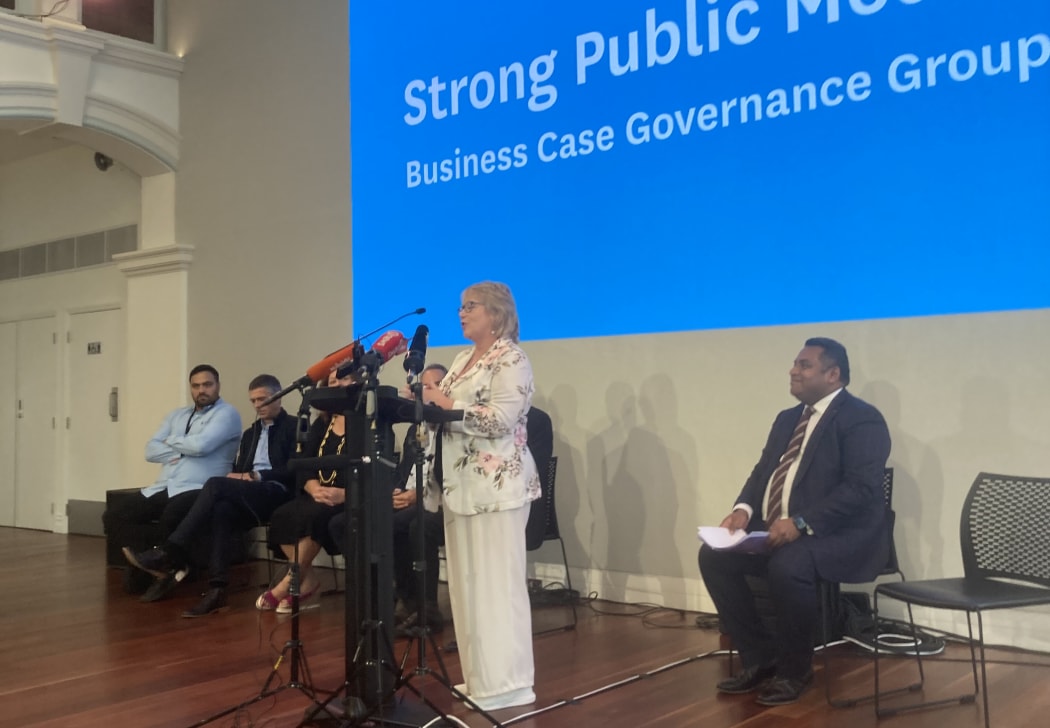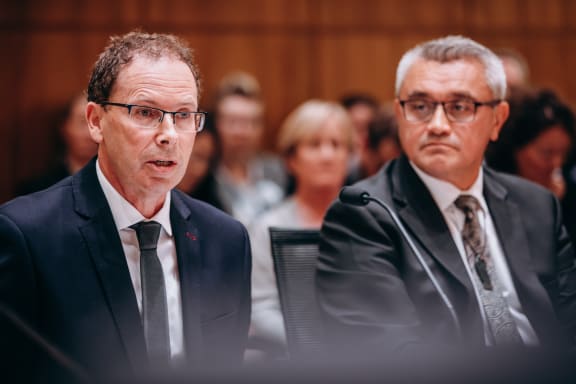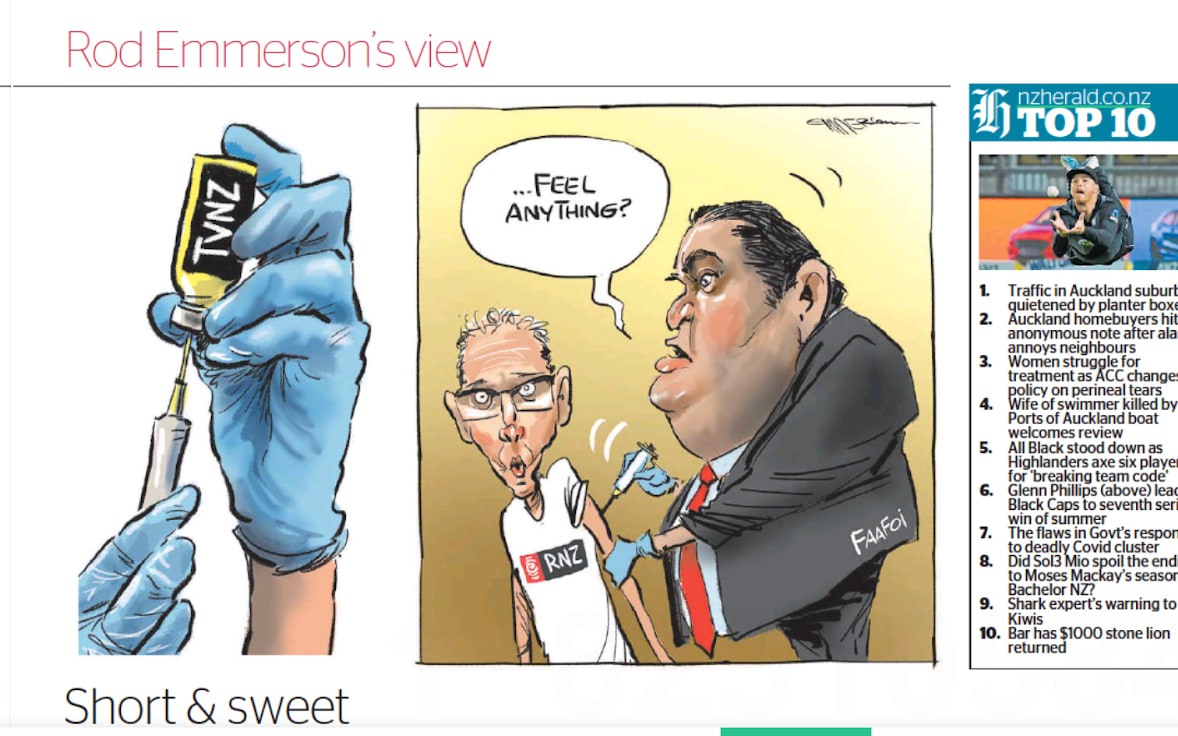The government appointed experts this week to oversee a business case which could be a blueprint for a new public media entity to replace TVNZ and RNZ - but the public won't see it before the government decides the issue later this year. Why are RNZ's top brass backing an idea about which so little is clear?

Photo: PHOTO / RNZ Mediawatch
The government’s plan moved a step forward this week when seven media people were appointed to oversee and scrutinise a business case which the Broadcasting, Communications and Digital Media Minister Kris Faafoi wants on his desk by mid-year.
He plans to take it to Cabinet for approval before the end of the year and last Wednesday Faafoi confirmed he wants a new outlet up and running by 2023.
The Strong Public Media Business Case Governance Group is chaired by former NZ First party deputy leader Tracey Martin, who pledged to speed up the process.
“People are frustrated that it has taken this long and the minister is as frustrated as everybody else,” she told reporters.
“While the people writing the business case can do it from a technical perspective, these individuals with real-life experience can identify if that’s not going to work. And we don't want to present to the minister something to take to Cabinet that won't work,” she said.
When Faafoi first put the idea before fellow minsters last year they wanted to know more about how it would work before disestablishing both existing broadcasters.
Consultancy company PwC was hired to create a business case for the Ministry of Culture and Heritage under the banner Strengthening Public Media.
That was put on ice when Covid-19 hit, but a year later the business case is now being put together by another crop of consultants from Deloitte.
The newly appointed expert group will also oversee the drafting of the charter which will govern a new entity - and also how it would “collaborate with and complement the work of private media”.
On Wednesday, Faafoi said “engaging with the public” will be part of the new group’s job but the Cabinet will make a decision without formally consulting the public or other political parties.
The government has insisted this is not a “merger” simply mashing together the non-commercial RNZ with highly commercial TVNZ, but Cabinet papers have made it clear the revenue will come from “Crown and non-Crown sources.”
In other words, a mix of public funding and commercial revenue. But how that could be created by 2023 out of the resources of two organisations with very different budgets, priorities and cultures is an unanswered question.
TVNZ’s chief executive Kevin Kenrick listed a series of unanswered questions when he spoke to Mediawatch a year ago.
“I think what really matters is: what is that entity is going to do? What audience is it going to serve? What sort of content? And how that might be delivered? What sort of skills and capabilities will the entity have?” he said.
A year later those things are no clearer and Kevin Kenrick told this year’s annual review of TVNZ last month TVNZ was merely an “observer” to what was going on at the Ministry for Culture and Heritage.
But RNZ’s top brass have been more enthusiastic.

Photo: RNZ / Dom Thomas
At RNZ’s annual review, chair Jim Mather even echoed the minister’s own language on strengthening public media when he declared RNZ’s strong support.
"We believe, as a board and executive team, it is a once-in-a generation opportunity to create a stronger public media system that would benefit all New Zealanders," he told Parliament's Social Services Committee.
The enthusiasm wasn't shared this week by the RNZ “insider” who wrote a comment for Newsroom.co.nz.
“Many at RNZ fear the radio entity will be subsumed by the larger, hungrier entity of television,” said the anonymous author.
Why are RNZ’s leaders backing the idea when so little is known about the public media entity being planned behind closed doors?
“We think there’s a strong case for more public broadcasting. We know the commercial media have increasing headwinds and there’s increasing misinformation and risks of polarisation linked to the rise of the digital platforms and all the disruption they bring,” Paul Thompson told Mediawatch.
“We think the best response is a media sector that’s sustainable and able to adapt and a key part should be a strong public media organisation,” he said.
“The status quo isn’t great. My view is that something is going to have to change. New Zealand has a low level of public media funding compared with similar nations and there are growing gaps in coverage.
“But we are not uncritical. We think that it needs to have a charter that enshrines its public media purpose and it needs to be sustainably funded,“ he said.
The one thing that’s clear is that the proposed new entity will have commercial revenue in the mix. RNZ is completely commercial-free.

Rod Emmerson's take on the plan for a new media entity in his Herald cartoon on April 1. Photo: photo / RNZ Mediawatch
“While that’s important, it shouldn’t dominate the thinking and discussion at this stage,” Thompson said.
“The Cabinet paper makes it really clear that the new entity - if it happens – will have a public purpose. Therefore, the funding model needs to support it,“ he said.
Labour-led governments have tried twice in the past 20 years to reform public television using TVNZ - and failed.
The TVNZ Charter introduced in 2003 lasted only eight years - and commercial-free TVNZ channels introduced in 2007 were dead five years later.
“A new public media entity that relied heavily on maintaining commercial revenue would automatically tilt towards maintaining those revenues and those commercial services. Somehow this new policy needs to make sure that doesn’t happen,” Thompson said.
“It comes down to the mandate for the entity enshrined in legislation - and that it has enough funding to underwrite the losses from commercial revenues which are likely to happen. That’s what I assume the new governance group is going to be putting its thoughts to,“ he said.
The consultants putting together the business case have also been directed to consider how a new public media entity would “collaborate with and complement the work of private media".
The capabilities of commercial media companies cannot be predicted in the foreseeable future. Should a media organisation serving the public have to take that into account?
“The last thing that New Zealand needs is a publicly owned and commercially funded - or commercially dominated - media entity that’s going to create more pressure for the media sector which is already experiencing lots of challenges. A public media entity needs to make the whole ecosystem healthier, not less healthy,“ Thompson said.
National Party broadcasting spokesperson Melissa Lee has put a series of written questions about the future of key RNZ and TVNZ services to the Broadcasting Minister. They received the same reply:
"The business case to assess the feasibility of creating a new public media entity is still being developed. Accordingly, no final decisions have been made about the future delivery of public media content."
But Paul Thompson insists RNZ is not stalled while the public media entity plan is pursued by the government and the Ministry for Culture and Heritage.
“We’ve got a new two-year strategic plan we're working on at the moment. There are new things in that. The vast majority of RNZ‘s activities are going to be relevant to the new entity anyway,“ he said.
“I think what the minister has asked is that if we are going to launch something significant we check ourselves and make sure that it can connect to the future that he’s building. It would be disastrous for us to sit still for two years while this thing happens around us,“ he said.
One thing that has stalled is the ill-fated youth service that RNZ proposed and then hastily scrapped a year ago after a fierce backlash and political intervention sparked by the cuts to RNZ Concert which were part of the same plan.
The 102FM frequency tagged for youth broadcasting - which RNZ failed to secure - remains unused while the future of RNZ itself is up in the year.
“Any decisions on its allocation will now likely be considered within the broader context of the work the government is doing on considering the viability of a new single public media entity,” the minister has confirmed.
“I think it was unlikely to be a quick resolution anyway even if the 'Strong Public Media' policy didn’t exist," Thompson said.
"What we decided is to do some new content for rangatahi in the next couple of years which doesn’t depend on access to (radio) spectrum. I think at some point that proposal will come back on the drawing board but we will do good things in the meantime,“ he said.
Will RNZ pursue the 102FM frequency?
“It is still tagged for young audiences so at some point someone needs to make a decision around how that’s allocated. We will do what we can in the meantime,” he said.
In the meantime RNZ‘s existing charter is due for review.
“The minister has indicated that he would like that review to be put on hold - and for the creation of the new charter for the proposed new entity to be the substantive process. I think it gives RNZ a good opportunity to contribute to the formation of the new charter," Thompson said.

